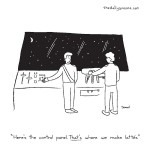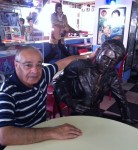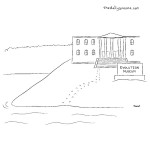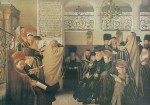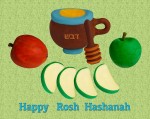For more cartoons, visit thedailysnooze.com.
Category: Life
This week’s cartoon … Oct. 16/15
For more cartoons, visit thedailysnooze.com.
The High Holidays in Beijing
The Confucius temple is a must-see in Beijing. (photo by Thyristorchopper)
On Sept. 7, I arrived in Beijing for a 10-month adventure – teaching Hebrew at Peking University. (Yes, this is what it is still called.)
Among the many preparations I had to make for this journey were learning some basic Mandarin, downloading and scanning for the students a huge amount of Hebrew material that would not be accessible from China, and packing clothes for three seasons. I also had to think about celebrating the High Holidays away from my family.
On the internet, I learned that Beijing’s Jewish community enjoys two congregations: Chabad, as one would expect almost anywhere in the world, and Kehillat Beijing, “an egalitarian, unaffiliated, lay-led Jewish community organization.” The latter has a rabbi, but only a guest one, and only during High Holidays. This year, they invited, for the second time, Rabbi Jack Shlachter, a physicist-rabbi from Los Alamos, N.M. What a small world! His wife, Bruria (Beverly), who would accompany him, was one of my mini-ulpan students in Santa Fe last year! In an email exchange, she assured me that Kehillat Beijing is a warm and welcoming community and, by the way, would I mind taking part and reading a passage during the Yom Kippur service?
The first few days on campus are full of bureaucratically required errands, and they are a good way to get familiar with the geography of my new and fascinating environment – a beautiful campus, part of which was the southern edge of a huge imperial garden. Surprisingly, it doesn’t feel as foreign as I expected it would. Global village? Still, there are enough things, even those on the mundane side, which are so different and curious, they promise more surprises.
Three days after arrival, I venture into the super-modern subway, heading to the Israeli embassy. The ambassador’s wife had invited Israeli women in Beijing for an informal potluck evening to welcome the New Year, and I am on the list. The instructions I receive from a student are clear: change from Line 4 to 10, take Exit B, walk two blocks into the diplomatic part of the city, and I am there.
There are about 20 women from what seems to be a close-knit group. Among them, a now local restaurateur, an architect, some businesswomen, an event planner, the Chabad rebbitzen, embassy employees, and wives of businessmen or embassy workers, taking time off from their jobs in Israel and enjoying all that Beijing has to offer – a good group for a newcomer to get her first tips about life in China. Late at night and after a rainstorm, I safely walk to the subway and back to my campus residence.
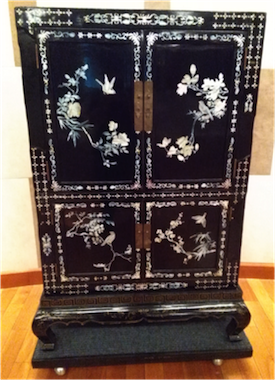
On Friday night, I head to Kehillat Beijing. I take the same subway station, but Exit A gives me my first glimpse of a busy downtown street, a shopping centre, hotels, the construction site of a large and creatively shaped tower, many tiny little – some elegant – stores (are all stores in Beijing so small?) and street food prepared and sold in small carts.
KB meets every Friday evening on the third floor of the Capital Club Athletic Centre. Local Jews, fluent in Mandarin, living in China for periods ranging from a few years to a couple of decades – business owners, financiers, ESL teachers, people working in the American, Canadian and Israeli embassies, students of Chinese or Chinese medicine, and others – get together with local Chinese who are searching for a new spiritual path, as well as with visitors. These visitors are tourists, exchange students and university professors, here temporarily, or those with great ideas, who come to explore business potentials.
The service this time is led by the guest rabbi in front a Chinese antique piece that has been turned into a small ark. If you look carefully, you will notice the probably unintentional Magen David-like decorations on its doors.
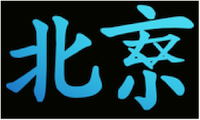
The KB logo, embroidered on their kippot, also has a Magen David in it, only here it replaces one element of the Chinese characters denoting the word Beijing. It is something to take home for your kippa collection.
After the service, there are announcements – and a surprise. One of the organizers of Limmud China, which alternates yearly between Beijing and Shanghai, tells us about this year’s event in November, and invites potential presenters to apply. I approach him and offer to do so, in this way compensating for having had to withdraw my offer to present at Limmud Vancouver 2016.
Friday and holiday services at KB are usually followed by dinner. Attendees buy a ticket but, for students, it is subsidized. The social mix at every table ensures interesting and lively conversations.
Saturday is my first day as a real tourist. I visit the Confucius temple site, with its ancient trees and long library “avenue” – all the Confucian wisdom engraved in close to 200 stelas, each more than twice a man-size tall. At the end, a class of university history students stages their version of an ancient bow and arrow shooting competition in historical clothing.
The next day is erev Rosh Hashana and Rabbi Jack leads the service in a meaningful, beautiful way. At my dinner table sits a British journalism professor, an American government envoy here to discuss drug issues with Chinese officials, a father visiting his Chinese-language-student son and an American university librarian hunting for both Jewish and Arabic publications produced in China, accompanied by two young guests: a Chinese woman writing her master’s thesis on Cynthia Ozick’s work and an Arabic-Chinese translator working in Chinese television. For both, it is their first time in a synagogue. The translator speaks to me in the formal literary Arabic he learned at Peking U and in Sudan, and I answer in my colloquial Arabic, explaining the meaning of the various Jewish New Year customs.
The next day, after Kiddush and a bite of challa dipped in honey, we head to nearby LiangMa (Bright Horse) River for Tashlich, right beside a few fishermen sitting patiently, waiting to hook a fish. From there, we walk for a few blocks and sit on the roof of a brewery, reserved today especially for the KB community to share in vegetarian pizza and drinks. It is an enjoyable, almost family-like, holiday gathering that extends to the late afternoon. By now, I feel quite at home. I speak Hebrew and English at this table and another and, from a trilingual (English, Chinese and Hebrew) 10-year-old girl, I get a detailed explanation and demonstration of the different tones and, hence, meaning of two Chinese words that sound equal to my ear.
On the second day of Rosh Hashana, KB does not hold services, and I join Rabbi Jack and Bruria at Chabad for another warm welcome. I am surprised to find a few of my new acquaintances from KB now here at Chabad. Dividing your “Jewish time” between the two very different congregations is not uncommon, I am told. In Beijing, the two communities collaborate, especially when it comes to the local Sunday school.
In between Rosh Hashana and Yom Kippur, school starts, and I meet my new students, as well as sprinkle in another couple of outings. I witness the locals dancing, playing games and singing, individually and in large groups, in their historical, beautifully preserved parks, taking advantage of the still nice weather and the unusually low pollution levels.
The Saturday between Rosh Hashana and Yom Kippur is a musical Shabbat at KB. The service is accompanied by a group comprised of members of the congregation and of Moishe House, with their instruments. Moishe House in Beijing seems to be very active, their events include dinners, movie nights, cultural discussions, speakers, holiday celebrations and community service events. They are also central in the preparations for Limmud and host its organizing meeting.
Yom Kippur I spend again with KB, starting with the meal before the fast and ending with the break fast, but for the first night of Sukkot, I head again to Chabad to sit in the sukka. This evening is busy. On top on their usual varied crowd, they are hosting a group of Chabad followers from New York, a tour organized by the Beijing rabbi as a fundraiser for the local day school, Gannenu. As erev Sukkot coincides this year with the Chinese Mid-
Autumn (Moon) Festival, the sukka, which usually would not be decorated, after the Chabad custom, now has bright, red Chinese lanterns hanging from its schach (covering), and traditional (kosher) moon cakes are served for dessert in small, red paper bags.
Barely three weeks and so much to remember already, with the Jewish aspects only being a part of my experiences so far, albeit a significant part. And there are nine more months to go. For the first time in my life, I have started writing a diary, lest I forget.
Rahel Halabe teaches biblical and modern Hebrew in Vancouver and, this year, in Beijing. She is the author of Hinneh: Biblical Hebrew the Practical Way, and a translator of Arabic literature into Hebrew.
Mystery photo … Sept. 25/15
Man with two girls holding a plaque, Peretz School, circa 1965. (photo from JWB fonds, JMABC L.14084)
If you know someone in this photo, please help the JI fill the gaps of its predecessor’s (the Jewish Western Bulletin’s) collection at the Jewish Museum and Archives of B.C. by contacting archives@jewishmuseum.ca or 604-257-5199. To find out who has been identified in the photos, visit jewishmuseum.ca/blog.
This week’s cartoon … Sept. 18/15
For more cartoons, visit thedailysnooze.com.
Burger with a side of Elvis anyone?
Uri Yoeli, left, at the Elvis Inn, his restaurant/convenience store/gas station in Neve Ilan. (photo by Deborah Fineblum Schabb)
To appreciate how much Israelis love Elvis Presley, you just have to hear three generations of the Mizrachi family of Rehovot crooning, “Wise men say only fools rush in … but I can’t help falling in love with you.”
The Mizrachis – mom Aliza, sons Asaf and Yehoram, and granddaughter Kahila – had just downed some American-style burgers at the Elvis Inn, a restaurant, convenience store and gas station that proudly claims to be the only Israeli institution devoted to “the King.” And they were busy inspecting the impressive Elvis memorabilia and tchotchke collection on the premises.
Drivers passing through this corner of the hills surrounding Jerusalem often do a double take from the car window when they spot not one, but two way-more-than-life-sized statues of Elvis. Unless, of course, they’re among those who, like the Mizrachis, make a special pilgrimage to the Elvis Inn, located in the small hillside town of Neve Ilan.
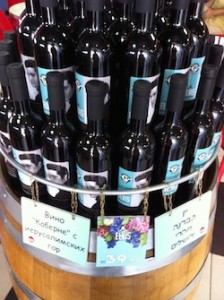
Where else can Israelis hear all Elvis, all the time, piped into a 1950s-style diner while they feast on burgers and fries? Where else can they purchase an Elvis mini-alarm clock, a platter-sized “Elvis in Jerusalem” plate, or a postcard with Elvis wearing tefillin in front of the Western Wall? (The latter souvenir comes thanks to Photoshop, since the King was never in Israel – the closest he got was Germany, and there is no evidence that he ever wore tefillin.) Better yet, buy a cup of coffee for 15 shekels (about $5 Cdn) and you get the ceramic Elvis mug to take home as a souvenir.
But nothing of this Elvis sanctuary was in the picture when Uri Yoeli was a 12-year-old growing up in Jerusalem, the seventh generation of his family to do so. The year was 1958 and the Israeli preteen had a girlfriend who was a hardcore fan.
“She gave me a picture of a man and said it was someone named Elvis,” he recalled. “The next week she gave me a small record – One Night with You.” Back then, his family owned one of just a handful of gramophones in all of Jerusalem, and being willing to repeatedly play the Elvis record instantly made Yoeli one of the most popular kids in the neighborhood.
“I didn’t understand one word of English but I knew this was great music,” he said nearly six decades later. So began a lifelong devotion to the King, punctuated with trips to Graceland (Elvis’ Memphis shrine) and an impressive collection of Elvis memorabilia, much of it now on display at Yoeli’s Elvis Inn.
Even during his years of Israel Defence Forces service, Yoeli’s Elvis fascination continued; he bought whatever posters and records he could get his hands on. In 1974, when he had the chance to open a gas station in Neve Ilan, he put a few of the Elvis pictures on the wall behind the cash register.
“That’s when I saw people’s reaction: ‘Wow, Elvis!’” he said. Thus, the Elvis Inn was born.
Over the years, the venue has grown, adding the two oversized statues – the brass one is a towering 16 feet high – and attracting not only Israelis, but plenty of Americans on vacation looking for some old-fashioned home cooking. (Note: any Elvis fans who keep kosher will have to pass on the food at the inn.)
To read more, visit jns.org.
Tips for holiday fasting
Judaism requires men and women to fast at specific times throughout the year. On Yom Kippur, the holiest of days, fasting – no food or drink – from sunset to sunset, is part of our path to achieve atonement.
By not putting food or drink into our mouth, we no longer stimulate the salivary glands and thereby prevent them from producing saliva. This can produce bad breath, among other things. Saliva aids digestion because it contains enzymes and chemicals that begin the initial breakdown of the many components in our foods; as well, it maintains the balance in our mouth between harmful and helpful bacteria. Here are 10 tips for the upcoming fast.
- Drink 64 to 80 ounces of water during the 24-hour period before the fast begins to replenish the saliva. On a typical day, we use up to 50 ounces of saliva and fasting may increase this amount.
- Avoid all alcohol during the 24-hour period before the fast begins. As well, note that most mouthwashes can contain up to 27% alcohol and, therefore, create a dry mouth, making our breath worse, not better.
- Use an alcohol-free, oxygen-rich mouthwash, which can increase saliva by four percent.
- Avoid toothpaste containing sodium lauryl sulfate (SLS), scientific term for soap, before and after the fast. SLS, an ingredient put into most toothpaste formulas to create a foaming action, is a severe drying agent. According to recent studies, SLS can lead to canker sores.
- Avoid breath mints and gum that contain sugar, before and after the fast. Sugar feeds all types of bacteria, especially those that create bad breath, gum disease and tooth decay.
- Avoid acidic vegetables, such as tomatoes, and fruits, such as grapefruits, oranges and their juices, during the 24-hour period before the past begins. These acids remain on the tooth surface and, due to the lack of saliva during the fast, they cannot be naturally neutralized.
- Eat lots of fruits and vegetables that contain a lot of liquid, such as apples, strawberries, blueberries, raspberries, blackberries, watermelon, celery and carrots. As an aside, eating parsley won’t help!
- Take all medications – primarily antihistamines, high blood pressure meds and antidepressants – immediately before the fast begins with lots of water. More than 75% of prescription medications have dry mouth syndrome as a side effect.
- Do not skip breakfast or any meal during the 24-hour period before the fast begins.
- Do not schedule a medical procedure that requires avoidance of food and drink during the 24-hour period before the fast begins.
For more information, visit therabreath.com.
This week’s cartoon … Sept. 11/15
For more cartoons, visit thedailysnooze.com.
We need less awe, more action
“Day of Atonement” by Isidor Kaufmann, circa 1900. “We cannot afford the luxury that accompanies the perception of atonement as an end unto itself. We must look at every facet of our lives, internal and external, collective and individual, and challenge ourselves to think anew,” argues Donniel Hartman. (photo from commons.wikimedia.org)
There are those who believe that the goal of Yom Kippur (Day of Atonement), as its name attests, is to merely attain atonement for our sins, to recalibrate our standing before God. These are called the Days of Awe, for our destiny stands in the balance: who will live and who will die. To achieve this atonement, we fast and pray for forgiveness.
The problem with this approach, however, is that, beyond fidelity to the laws and practices of the holy days, it does not make any other demands upon us. Instead of striving to change our behavior, we are satisfied with the yearning for atonement. The old year fades out and a new one approaches, and everything stays as it was.
There is much experience of awe in the Days of Awe, but there is little action. Instead of serving as a catalyst for change, the High Holidays often remain a line of defence for the status quo, a defence achieved by the idea of atonement itself. Isaiah’s critique against his generation, who complained before God, “Why, when we fasted, did You not see? When we starved our bodies, did You pay no heed?” (Isaiah 58:3), continues to reverberate and have new significance.
What is the cause for this continuing failure? I believe that it may be found in the fact that the idea of atonement has two distinct meanings and we, unfortunately, give preference to the more convenient and easy one. Atonement can be viewed as an end unto itself or as a means that enables a new beginning. As an end unto itself, its goal is to change the consequences of past behavior and not to change the behavior itself. God is the one who atones for past mistakes and erases them from the equation. Yom Kippur has a goal to recalibrate the world, a form of restart button. However, as an end unto itself, it enables the human being to start over from the same place and to wait again for the next Yom Kippur with its promised “new beginning.”
On the other hand, atonement can be viewed as a means. Its importance is derived precisely from the fact that it has the capacity to enable and serve as a catalyst for change and renewal.
One of the major stumbling blocks that prevents us from changing our behavior is the difficulty in believing that we are capable of it. We are shackled to mediocrity and the status quo, for we often believe that we are ruled by the past and that it defines us in the present and will continue to do so in the future. The idea of atonement can serve as the ally of the status quo or as the vehicle of liberation from it. A human being who achieves atonement can squander this moment of grace by repeating the mistakes of the past, or he or she can use atonement to establish the belief that the past does not necessarily define who we will be in the future. One who receives the gift of atonement is given a chance to reshape one’s life; the critical question is whether we use this gift or waste it by believing that atonement as an end unto itself is sufficient.
The rabbinic tradition understood both the challenge and danger embedded in the idea of atonement. It consequently ruled that Yom Kippur atones only when it is accompanied by tshuva (Mishnah Yoma 8:8). The days are truly Days of Awe, for they are days of reckoning, not merely with God, but primarily with ourselves and regarding our lives. This notion of a day of reckoning requires us to go beyond the experience of the awe that accompanies these days and to act and challenge ourselves to embark on new directions for our lives. To do so, however, we must not merely pray, but must internalize the central category that fulfils a key role throughout the rituals of the Days of Awe – hattanu – we have sinned.
The purpose of the ritual of confession, the Al Het, is not to remove our sins from the eyes of God, but to establish them in front of our eyes. It is only a human being who recognizes his or her limitations and who strips away the aura of self-righteousness who can recognize both the need and responsibility to change.
It is not simple to be a Jew, for we are obligated to strive for excellence and to see in a life of mediocrity a contradiction to our identity. We cannot afford the luxury that accompanies the perception of atonement as an end unto itself. We must look at every facet of our lives, internal and external, collective and individual, and challenge ourselves to think anew. We must reconnect to our values and ideals, and find new ways to allow them to guide our individual and national lives.
May these Days of Awe serve as a spiritual foundation and moral anchor for the renewal of our people. May we truly believe in our potential for renewal and may this belief give birth to new levels of aspirations, dreaming and action. May this year be a year of health, happiness and peace. Shana tova.
Donniel Hartman is president of Shalom Hartman Institute and director of the Engaging Israel Project. He contributes a regular column to Times of Israel and writes for many other publications on a regular basis. This article can be found on the Shalom Hartman Institute website, hartman.org.il, and is reprinted with permission.
Make the New Year sweeter
Apples and honey are essential at Rosh Hashana’s festive table. An old tradition of eating apples dipped in honey reflects our hopes for “sweet” and prosperous New Year. Shall we try and make this treat together?
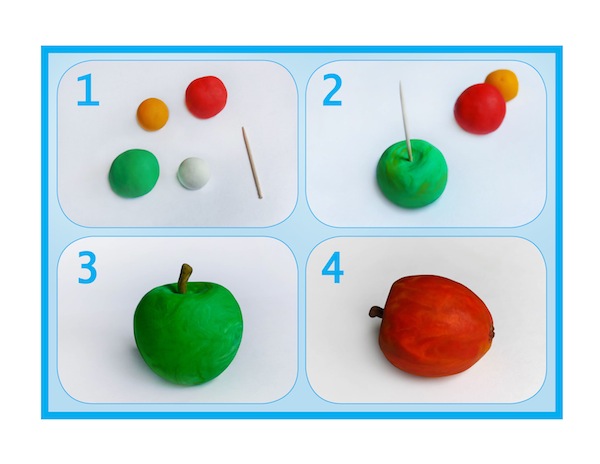 1. Take a toothpick and a few pieces of modeling clay (or Plasticine) in green, yellow, red and white colors.
1. Take a toothpick and a few pieces of modeling clay (or Plasticine) in green, yellow, red and white colors.
2. Mix well a piece of green and a small amount of yellow modeling clay. Make a ball out of this mixture and, using the toothpick, make a hole in the bottom of the ball.
3. Next, you can make a stem for your apple by sticking a small brown piece of clay in the hole that you made. Your apple is ready!
4. Mix well a piece of red modeling clay and a small amount of yellow. Follow the procedure in Step 2 and make a red apple. Don’t forget about giving your apple a “tail” and a “nose” using brown clay.
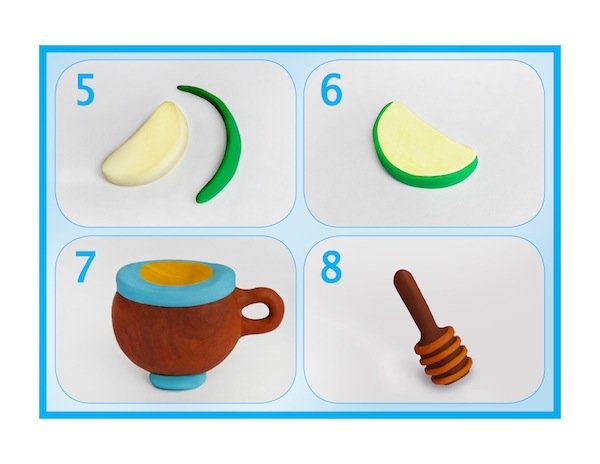 5. It is time to make some apple slices. Take white modeling clay and mix it with yellow. Shape the mixture into a crescent. Make the skin of an apple from green modeling clay.
5. It is time to make some apple slices. Take white modeling clay and mix it with yellow. Shape the mixture into a crescent. Make the skin of an apple from green modeling clay.
6. Combine the crescent shape with the skin and your apple slice is ready. Make a few such slices.
7. We still need to make a pot of honey. For that, we use brown and blue modeling clay. First, make a brown pot, and then add a blue rim to it. Also attach a little handle to the side of your pot. “Fill” your pot with honey by putting a little oval made from yellow modeling clay on top.
8. Now we only need to make a dipper. Take brown modeling clay and roll it into a stick shape. It has to be thinner on one end and wider on another, resembling a hammer. To create the illusion of carving, typical for a dipper, encircle the wide part of it with few horizontal stripes made from orange clay.
Remember, you can use the toothpick to refine all your pieces of art. As well, before you start working with a new color, wipe your hands with a napkin to prevent the unwanted mixing of colors. And, most important of all – use your imagination! There are no strict rules when it comes to creativity. Don’t be afraid to experiment with colors.
Once you’ve finished your creations, if you put together all the pieces that you have made and take a picture, you will have a wonderful and unique Rosh Hashana greeting card.
Sweet and prosperous Rosh Hashana wishes to all the artists and all the Jewish Independent readers!
Lana Lagoonca is a graphic designer, author and illustrator. At curlyorli.com, there are more free lessons, along with information about Curly Orli merchandise.

